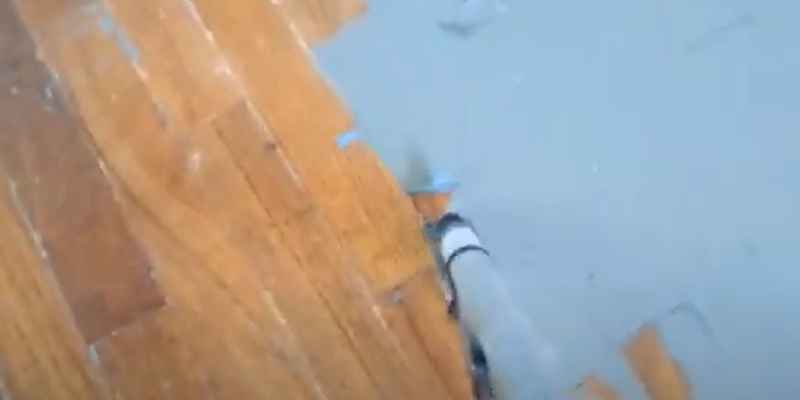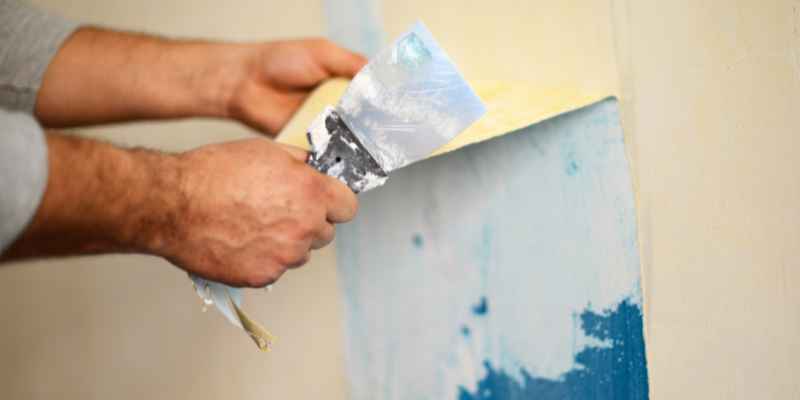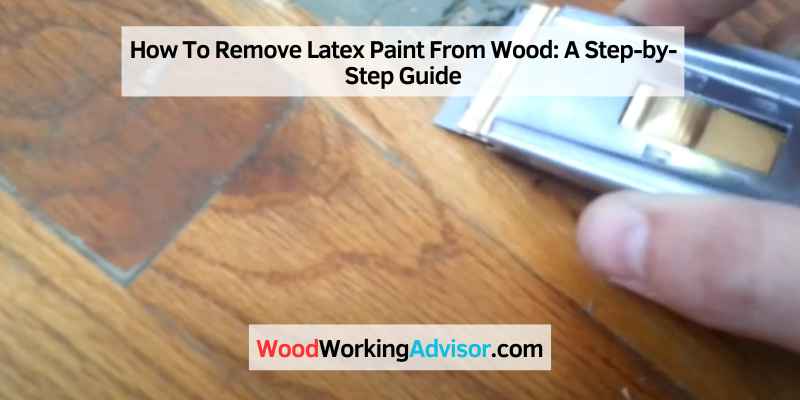To remove latex paint from wood, you can use a combination of rubbing alcohol and a scraper. Gently apply rubbing alcohol using a cloth or sponge to soften the paint, then use the scraper to carefully lift it off the wood surface.
Be cautious not to damage the wood while scraping. Removing latex paint from wood can be a daunting task, but with the right techniques, it can be accomplished effectively. Whether you accidentally spilled latex paint on your wooden furniture or need to restore an old wooden surface, knowing how to remove the paint without causing damage is crucial.
Fortunately, there is a simple and straightforward method that can help you achieve this. By using rubbing alcohol and a scraper, you can effectively soften and remove the latex paint from the wood without leaving behind any residue. We will guide you through the step-by-step process of removing latex paint from wood, ensuring your furniture or wooden surface looks as good as new.
Safety Precautions
When removing latex paint from wood, it is crucial to prioritize safety precautions. Here are some important measures to consider:
Wear Protective Clothing
Before starting the paint removal process, it is essential to wear the appropriate protective clothing to keep yourself safe from potential hazards. This includes:
- A pair of gloves to protect your hands from chemicals and sharp tools.
- A long-sleeved shirt and pants to safeguard your skin from splatters and drips.
- Protective eyewear, such as safety goggles, to shield your eyes from paint particles and any debris that may fly off during the process.
- A respirator or mask designed for paint removal to prevent inhalation of harmful fumes and dust particles. Ensure the respirator fits securely and provides adequate protection against paint fumes.
Work In A Well-ventilated Area
Always perform paint removal in a well-ventilated area to minimize exposure to toxic fumes. Proper ventilation ensures fresh air circulation and reduces the potential harm caused by inhaling chemical vapors. Here are a few tips to ensure a well-ventilated workspace:
- Choose an area with windows or doors that can be opened to allow fresh air to enter.
- If working indoors, consider using fans or exhaust systems to improve airflow and carry away any fumes.
- Avoid confined spaces with limited ventilation, as this can increase the concentration of harmful fumes. Opt for a spacious area whenever possible.
By following these safety precautions, you can effectively remove latex paint from wood while minimizing potential risks to your health and well-being. Make sure to prioritize your safety throughout the entire paint removal process.

Supplies You’ll Need
To remove latex paint from wood, you’ll need a few supplies like a scraper, denatured alcohol, and fine-grit sandpaper. These tools will help you effectively strip away the paint without damaging the wood surface.
Plastic Drop Cloth
To successfully remove latex paint from wood, you will need a few essential supplies. First on the list is a plastic drop cloth. This is an important item that will protect your work area from any paint splatters or spills. By placing the plastic drop cloth under the area you’ll be working on, you can ensure easy cleanup and prevent any damage to your floor or furniture.
Paint Scraper
A paint scraper is an indispensable tool when it comes to removing dried latex paint from wood surfaces. This handheld tool has a sharp blade that allows you to gently scrape away the paint without causing any damage to the underlying wood. Using a paint scraper is an effective and efficient way to lift off paint that has dried and hardened onto the wood surface.
Denatured Alcohol
Denatured alcohol is a powerful solvent that can effectively dissolve and remove latex paint from wood. It is readily available at most hardware stores and is often used as a cleaner and degreaser. When using denatured alcohol, remember to wear gloves and work in a well-ventilated area as the fumes can be strong. Soak a clean cloth or sponge in the denatured alcohol and gently scrub the painted surface to lift off the paint.
Clean Cloth Or Sponge
A clean cloth or sponge is essential for the paint removal process. Whether you are using denatured alcohol or any other substance, this versatile tool will help to effectively apply the solvent and remove the loosened paint. Make sure the cloth or sponge is clean and dampen it with the solvent of your choice. It is recommended to use a white cloth to avoid any color transfer onto the wood.
Fine-grit Sandpaper
When dealing with stubborn latex paint that is deeply embedded into the wood, a fine-grit sandpaper can come to the rescue. This sandpaper is specifically designed to gently buff away the paint layer by layer. By using light pressure and sanding in the direction of the wood grain, you can gradually remove the paint without causing any scratches or damage to the wood surface. Remember to wipe away any dust or particles with a clean cloth after sanding.
Step 1: Prepare The Area
To remove latex paint from wood, begin by preparing the area. Clear the space of any furniture or other items to avoid damage and cover the surrounding surfaces with drop cloths or plastic sheets to protect them from paint splatters and spills.
Removing latex paint from wood requires careful preparation to ensure a clean and efficient process. By taking the time to prepare the area, you can minimize mess and damage to surrounding surfaces. Follow these steps to get started:
Cover Nearby Surfaces With A Plastic Drop Cloth
To protect nearby surfaces from any accidental drips or splatters, cover them with a plastic drop cloth. This will provide a barrier between the paint stripper and any other objects, preventing unsightly stains or damage. Make sure the drop cloth is secured in place to avoid any mishaps during the paint removal process.
Ensure Adequate Ventilation
Proper ventilation is crucial when working with paint strippers, as these chemicals can release strong fumes. Open windows and doors in the area to promote air circulation and prevent any potential health risks. If the space does not have sufficient natural ventilation, consider using fans or wearing protective masks to ensure a safe environment.
By taking these preparatory steps, you can create a suitable workspace for removing latex paint from wood. With a covered and well-ventilated area, you’ll be ready to move on to the next step and tackle the paint removal process itself. Stay tuned for Step 2: Gather the necessary tools and supplies.
Step 2: Scrape Off The Excess Paint
In Step 2 of removing latex paint from wood, scrape off any excess paint to prepare the surface for further cleaning and restoration.
Use A Paint Scraper To Gently Remove As Much Paint As Possible
When it comes to removing latex paint from wood, one of the essential steps is scraping off the excess paint. To do this, you will need a paint scraper, which is a tool specifically designed for this purpose. With the paint scraper in hand, you can carefully and gently remove as much paint as possible from the wood surface.
It’s important to be cautious while scraping to avoid damaging the wood underneath. Start by holding the scraper at a shallow angle and applying light pressure. This will help you loosen the paint without causing any harm to the wood. Move the scraper in short, smooth strokes, working in the direction of the paint’s grain.
Ensure that the entire painted area is covered, paying attention to corners and edges where the paint may have pooled or dripped. Take your time and be patient, as rushing through this step could result in scratches or damage to the wood.
If the paint doesn’t come off easily, you can try applying a small amount of warm water to soften it. Gently scrape again after allowing the water to sit for a few minutes. Just be careful not to oversaturate the wood, as excessive moisture can cause warping or other issues.
Once you’ve removed as much paint as possible with the scraper, you can move on to the next step in the paint removal process. Remember, the goal here is to eliminate as many layers of paint as you can without causing any harm to the wood surface.
Step 3: Apply Denatured Alcohol
In Step 3 of removing latex paint from wood, apply denatured alcohol to dissolve the paint effectively. This process helps to restore the wood’s natural beauty without damaging the surface.
When it comes to removing latex paint from wood, applying denatured alcohol can be a game-changer. This powerful solvent helps to break down the paint and make it easier to remove. Follow these simple steps to effectively use denatured alcohol in the paint removal process.
Dampen A Clean Cloth Or Sponge With Denatured Alcohol
To begin, dampen a clean cloth or sponge with denatured alcohol. This will ensure that the alcohol is easily applied to the affected area.
Rub The Affected Area In A Circular Motion
Take the dampened cloth or sponge and rub the affected area in a gentle circular motion. This will help to loosen and dissolve the latex paint, making it easier to remove.
Note: If the paint is particularly stubborn, you may need to repeat this step multiple times until the paint is fully removed.
Using denatured alcohol is a highly effective method for removing latex paint from wood surfaces. By following these simple steps, you can easily restore the natural beauty of your wooden furniture or flooring.

Step 4: Repeat If Necessary
To remove latex paint from wood, repeat the necessary steps for effective removal. This ensures thorough cleaning and restoration of the wood’s original appearance.
If you’ve followed the previous steps and still have some lingering latex paint on your wood surface, don’t worry. Just like any other task, persistence is key. This is the stage where you’ll continue applying denatured alcohol and scrubbing until the paint is fully removed. Let’s go ahead and take a closer look at this step.
First, make sure you have a bottle of denatured alcohol handy. It can be easily purchased from your local hardware store. Apply a generous amount of denatured alcohol to a clean cloth or sponge, and once again, gently rub the affected area where the paint remains.
If the paint is being stubborn and not budging, it’s time to bring out the heavy artillery – fine-grit sandpaper. Using a fine-grit sandpaper, carefully sand away at the paint until it begins to loosen. Be sure to sand in the direction of the wood grain to avoid any potential damage.
Remember, patience is key during this process. Take your time and keep repeating the application of denatured alcohol and sanding until the paint completely disappears from the wood surface.
Once you’ve successfully removed the paint, wipe down the area with a clean, damp cloth to remove any residue left behind. This will ensure a flawless finish.
So, whether you’re dealing with a small dab or a larger paint spill, following these steps and being persistent will help you achieve a paint-free wood surface. With a little bit of effort and the right tools, your wood will look as good as new.
Step 5: Clean And Protect The Wood
Step 5: Clean and Protect the Wood – Learn how to effectively remove latex paint from wood and ensure its long-lasting protection with these simple steps. Safely clean the surface, apply appropriate solvents, and follow with a protective sealant to maintain the beauty and integrity of your wooden surfaces.
After successfully removing the latex paint from your wood surface, it’s important to give it some care to ensure its longevity and maintain its natural beauty. Here are two simple and effective steps you can take to clean and protect the wood:
Wipe Down The Wood With A Clean, Damp Cloth
To start, take a clean, damp cloth and gently wipe down the wood surface to remove any remaining residue or dust. This will help create a clean canvas for the next step. Be sure not to use excessive water or soak the wood, as this can cause damage. Just a damp cloth will do the trick.
Apply A Wood Sealer Or Polish To Protect The Surface
Once the wood is clean and dry, it’s time to provide some extra protection for the surface. Applying a wood sealer or polish will not only enhance the wood’s natural beauty but also create a protective barrier against future stains and damage.
Here’s how to do it:
- Gently shake the wood sealer or polish bottle to ensure it is well mixed.
- Apply a small amount of the product onto a clean, lint-free cloth or sponge.
- Using gentle, circular motions, spread the sealer or polish evenly across the wood surface.
- Make sure to reach all the nooks and crannies, ensuring complete coverage.
- Allow the sealer or polish to dry according to the product instructions.
- Once dry, take a clean cloth and gently buff the wood surface to reveal a beautiful shine.
By following these simple steps, you’ll not only clean away any remnants of latex paint but also provide the necessary protection to keep your wood looking its best for years to come.
Conclusion
Removing latex paint from wood can be a daunting task, but with the right techniques and patience, it is possible to restore your wood surfaces to their former glory. By carefully following the steps outlined in this guide, you can effectively remove latex paint without causing damage to the wood.
Remember to protect yourself with appropriate safety measures and use gentle methods to achieve the best results. With a little effort and care, you can enjoy beautifully restored wood surfaces that enhance the overall aesthetic of your space.


